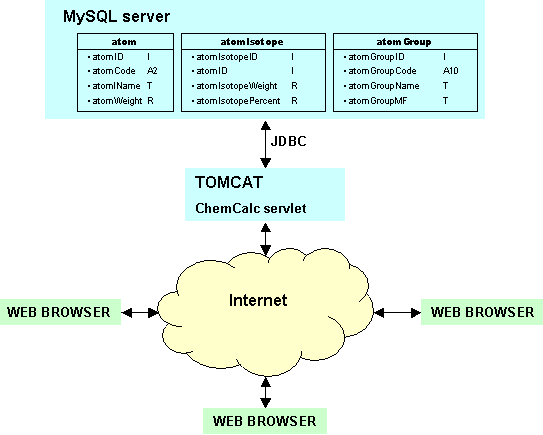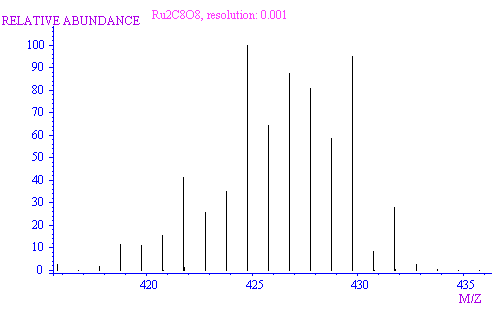
Scheme 1 : Global description of the program
Easy calculation of molecular formula, molecular weight and isotopic distribution of peptides.
Michal Krompiec1 and Luc Patiny*2
1 Faculty of Chemistry, Silesian University of Technology, ul. M.Strzody 9, PL-44100 Gliwice, Poland
2 Institute of Organic Chemistry, University of Lausanne, BCH-Dorigny, CH-1015 Lausanne, Switzerland. E-mail: [email protected]
Received: 15 August 2001 / Uploaded 22 August 2001
Since the publication by Antoine Lavoisier in 1789 of the "Traité Elementaire de Chimie" where he presents a list of 55 "elements" [1], the chemists have been interested in the atomic composition of a molecule. A few years later, Avogadro suggested a simple method allowing to determine the relative weight of the different "elementary molecules" [2] that are currently known as atoms. During over a century, the molecular weight and the elemental analysis were the main properties used to explain and discover many reactions. Even if today these properties are rarely used to determine the structure of a product, they are still of main importance to calculate the quantities involved in a reaction as well as to check the product purity.
So why one more paper about this simple problem ? Indeed this problem seems trivial : you count the number of atoms, check the atomic mass and get directly the molecular weight and elemental composition. For large molecules, and mainly in the peptidic field, this may not always be trivial. Indeed, how to calculate the molecular formula and molecular weight of Oxytocin, a nonapeptide used clinically for the initiation and maintenance of uterine contractions, for which the reduced form has the follow ing molecular structure : HCysTyrIleGlnAsnCysProLeuGlyNH2. This problem can be even more complex if the molecular weight of a protected form like Cys(Trt)Tyr(tBu)IleGln(Trt)Asn(Trt)ProLeuGlyNH2 has to be calculated. Some programs like ChemDraw or ACDSketch are able to calculate those parameters but require that you draw the structure. Many small utilities are also available on the internet [3] that were developed in Javascript, Java, SuperCard, ... Among them, the application Molecular Weight Calculator from Matthew Monroe is of particular interest and allows to calculate molecular formula, molecular weight and isotopic distribution and to define the groups and add new atoms.
Here we describe a different approach to develop a freely available and efficient way to calculate the molecular formula, molecular weight, exact mass, isotopic distribution and elemental analysis by entering a formula the way a chemist thinks about it on the website http://www.chemcalc.org/.
In order to be widely accessible, customizable and free, the following tools were used : MySQL, a freely available database engine, Tomcat, a servlet server, Java to write the program as a servlet. Communication between the database and the servlet was achieved using JDBC and mm.mysql drivers. All the information required for the calculations are stored in three different tables : atoms, isotopes and groups of atoms. The content of all the data stored can be directly checked from the web site. Moreover, users from the Internet will soon be directly able to define new atom groups (Scheme 1).

Scheme 1 : Global description of the program
The mai n advantages of this solution are :
This program analyzes a molecular formula using the following special rules :
A group of atom is always defined as an uppercase followed by 0 to 10 lowercases (Tbdms, Z, ...). Currently over 100 groups are defined in ChemCalc. Among them, the amino acids are defined using the 3 letters code as a diradical allowing to easily describe a peptidic sequence. For example, Gly is defined as NH-CH2-CO. All the amino acids that can be protected are also defined using a 4 lett ers code (3 letters + "p") as the triradical. Therefore, to have to the correct mass for the serine protected on the lateral chain by a Boc, HOSerpBocH should be entered. Most of the usual protecting groups used in peptidic synthesis are also predefined.
Here is just one small example for Ru2(CO)8 :
You entered: Ru2(CO)8
The formula is: Ru2C8O8
Mass: 426.2232
Elemental analysis of Ru2C8O8:
Ru: 47.4259%
O: 30.0301%

If you want to try your own examples, you may enter directly your molecular formula here :
This paper discribes a new tool for molecular formula calculations on the internet especially suitable for large molecules like protected peptides.
1. Henry Guerlac, "Antoine-Laurent Lavoisier: Chemist and Revolutionary", Scribner, New York, NY, 1975. 174 pages.
2. Mario Morselli, "Amedeo Avogadro, A Scientific Biography", Kluwer Academic Publishers, USA, 1984.
3. Some examples of existing molecular formula calculator. Javascript : molform (http://www.chemie.fu-berlin.de/cgi-bin/molform), Frosh Chem Interactive Utility (http://www.cs.cmu.edu/~dmazzoni/chem.html), Molar Mass Calculator (http://www.ktf-split.hr/periodni/en/molmasa.html); Java applets : Molecular Weight Calculation (http://www.ch.cam.ac.uk/magnus/MolWeight.html), Molecular Weight Calculator (http://www.chemicalogic.com/mwcalc/mwjava.htm); SuperCard on macintosh, Sheffield ChemPuter (http://www.shef.ac.uk/chemistry/chemputer/isotopes.html, http://www.shef.ac.uk/chemistry/chemputer/percent.html); Molecular Weight Calculator, a very nice program on windows (http://www.unc.edu/~monroem/features95.html)
4. Jspec Applet. Reference : Tonge, A. P.; Rzepa, H. S; Yoshida, H. J. Chem. Inf. Comp. Sci. 1999, 483.